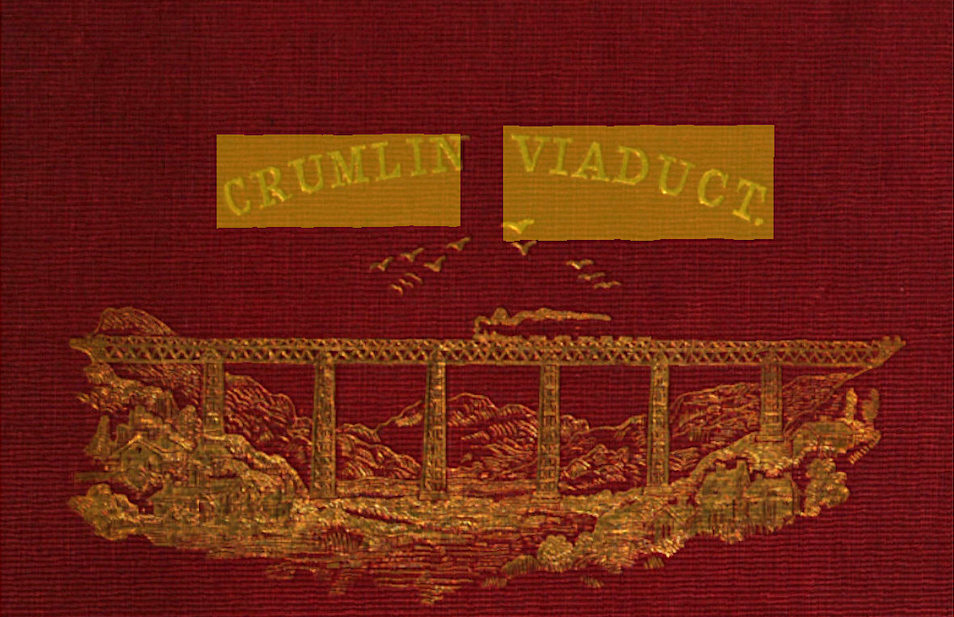
The Crumlin Viaduct, on the cross-valleys line from Pontypool Road to Quakers Yard, built during 1853-57, and "in some respects, the most remarkable bridge in the world" (Napier et al., 221). Source: frontispiece to Maynard.
The contract for constructing a viaduct here was won by the Kennard Brothers — that is, Thomas William Kennard (1825-1893) and Henry Martyn Kennard (1833-1911). Like all such major projects, others were involved as well. The engineer of the railway, Charles Liddell (1813-1894) of Liddell and Gordon, a London firm, rendered "very valuable assistance" (Maynard 31); and the brothers' father, Robert William Kennard (1800-1870) MP for Newport, Isle of Wight, would also have been consulted. The older Kinnard was a partner in the Blaenavon Iron and Coal Company directed by his sons, and in the Falkirk Iron Company, too. The wrought iron components were produced at the former, where the assembly work took place, and the castings at Falkirk (see "Crumlin Viaduct Works"). Vitally important, in addition to these, was Captain James Warren (1802-1870), who invented the type of trusses used (see "James Warren"). In fact, in apportioning credit for the viaduct a few years after it was opened, one professional journal starts with Warren: Liddell & Gordon, the engineers, and "Messrs. Kennard, the contractors" come next in importance (Napier et al. 221).


Right: Diagrams showing the trusses from different angles (Maynard, following p. 15). Left: Embossed design on the binding of Maynard's book.
Technically speaking, the girders forming the bridge deck at Crumlin are not lattice trusses - which have multiple diagonal members in diamond-shaped patterns. The W shape of these trusses' members is what makes them Warren trusses. Note the train passing over the viaduct, both in the top picture and the one on the book binding. The trains must have looked tiny at this height, and the views must have been amazing.
As well as local passenger services, the viaduct carried coal on a more direct route to the English Midlands than that via Newport. Fabricated in cast iron for the columns and wrought iron for the trussed deck and cross-bracing, it was the highest railway bridge in the country, and the third highest in the world (see Harter 344). It was finally demolished in 1966-67.
Henry N. Maynard, who became manager of the Crumlin works, gives more detail about it:
Crumlin Viaduct, situated in one of the most picturesque spots in the county of Monmouth, and in what is geologically termed the South Wales coal basin, is distant from Pontypool four and a half, and from Newport, twelve miles; carries the West Midland section of the Great Western Railway across the charming valley of the river Ebbw, about seven miles from the great ironworks of Ebbw Vale, Nantyglow, &c. Is an example of the class ... known as Kennard and Warren's patent girders, consists of ten spans of 150 feet each, measured from centre to centre of supports, total length, including abutments, 1,658 feet, and is constructed to carry a double line of railway upon iron piers of great height.... Many other bridges of this class have been made since the Crumlin Viaduct.... [6]
The works at Crumlin disappeared long before the viaduct: the company was liquidated in 1878 (see "Crumlin Viaduct Works"). Note that the engineer Charles Liddell was the uncle of Alice Liddell, of Alice in Wonderland fame.
Image scans by Jacqueline Banerjee and commentary by Colin Price and Banerjee. You may use the images without prior permission for any scholarly or educational purpose as long as you (1) credit the person who scanned them and (2) link your document to this URL in a web document or to the Victorian Web in a print document. [Click on the images to enlarge them.]
Bibliography
"Charles Liddell." Grace's Guide. Web. 1 April 2022.
"Crumlin Viaduct Works." Grace's Guide. Web. 1 April 2022.
"James Warren." Grace's Guide. Web. 1 April 2022.
Harter, Jim. World Railways of the Nineteenth Century: A Pictorial History in Victorian Engravings. Baltimore and London: Johns Hopkins University, 2005.
Maynard, Henry N. The Viaduct works’ handbook; being a collection of examples from actual practice of viaducts, bridges, roofs, and other structures in iron..... London: E. and F.N. Spon, 1868. Internet Archive. Contributed by the University of Michigan. Web. 1 April 2022.
Napier, James Robert, Walter Neilson, and W.J. Macquorn Rankin. "Report on the Progress and State of Applied Mechanics." Proceedings of the Royal Philosophical Society of Glasgow. Vol IV (1860). London and Glasgow: Richard Griffin & Co., 1860. 207-30 (see item 56). Google Books. Free Ebook.
Created 1 April 2022